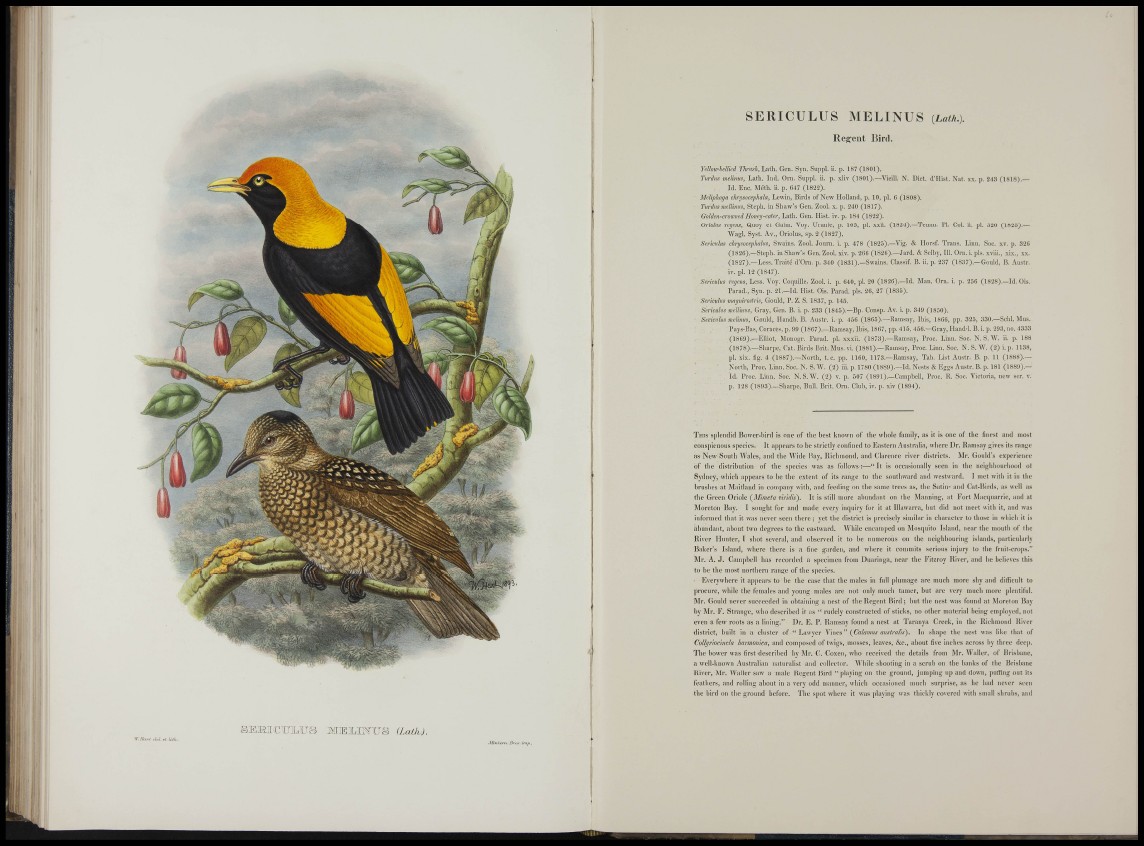
' l i i
II' :•
I (\ :
W;i' ' I :
; i
ï i , .
i
W. IhiH Ft Ulh .
S I E H I C T L I I L i U S M I E I L I Î f T J i S (Lalh.).
. Miiitf.tii Br-vf. irn^j.
SERICULUS MELINUS [Laïk.).
Reg'ent Bird.
YelhwMKei nnisi, Lath. Gen. Syii. Suppl ii. p. 187 (1801).
Turdus melimis, Lath. Ind. Orn. Suppl. ii. p. xhv (1801).—Vieill. N. Diet. d'Ilist. Nat. xx. p. 243 (1818).—
Id. Eue. Métli. ii, p. 647 (1822).
MeMfhaga chnjsocephala, Lewiii, Birds of New Holland, p. 10, pl. c (1808).
Tnrdtis mellinus, Steph. in Shaw' s Gen. Zool. x. p. 240 (1817).
Golden-crowmd Homy-eater, Lath. Gen. Hist. iv. p. 184 (1822).
Oriolus regens, Quoy et Gaim. Voy. Uranie, p. 105, pl. xxii. (1824).—Temm. Pl. Col. ii. pl. 320 (1825).—
Wagl. Syst. Av., Oriolus, sp. 2 (1827).
Serîclihts chrysocepliahs, Swains. Zool. Journ. i. p, 478 (1825).—Vig. & Ilorsf. Trans. Linn. Soc. xv. p. 320
(1826).—Steph. in Shaw' s Gen. Zool. xiv. p. 2(ifi (1820) .—Jard. & Selby, 111. Orn. i. pis. xviii., xix., xx.
(1827).—Less. Traité d'Orn, p. 340 (1831).—Swains. Classif. B. ii. p. 237 (1837).—Gould, B. Austr.
iv. pl. 12 (1847).
Sericulus regens. Less. Voy. Coquille, Zool. i. p. 640, pl. 20 (1826).—Id. Man. Oi-n. i. p. 250 (1828).—Id. Ois.
Parad., Syu. p. 21.—Id. Hist. Ois. Parad. pis. 26, 27 (1835).
Sericulus mngmrostris, Gould, P. Z. S. 1837, p. 145.
Seriadtis meUims, Gray, Geu. B. i. p. 233 (1845).—Bp. Consp. Av. i. p. 349 (1850).
Serimliis melhnis, Gould, Ilandb. B. Austr. i. p. 456 (1865).—Uamsay, Ibis, 1866, pp. 325, 330.—Schl. Mus.
Pays-Bas, Coraces, p. 00 (1867).—Ramsay, Ibis, 1807, pp. 415, 456.—Gray, Hand-1. B. i. p. 203, no. 4333
( 1 8 6 ! ) ) . ^ E l l i o t , Mouogr. Parad. pl. xxxii. (1873).—Ramsay, Proe. Linn. Soc. N. S. W. ii. p. 188
(1878).—Sharpe, Cat. Birds Brit. Mus. vi. (1881) .—Ramsay, Proe. Limi. Soc. N. S. W. (2) i. p. 1138,
pl. xix. fig. 4 (1887).—North, t. c. pp. 1160, 1173.—Ramsay, Tab. List Austr. B. p. 11 (1888).—
North, Proe. Linn. Soc. N, S .W. (2) iii. p. 1780 (1889) .—Id. Nests & Eggs Austr. B. p. 181 (1889).—
Id. Proe. Linn. Soc. N. S. W . (2) y. p. 507 (1891).—Campbell, Proe. R. Soc. Victoria, new ser. v.
p. 128 (1893).—Sharpe, Bull. Brit. Orn. Club, iv. p. xiv (1894).
THIS spieiitlid Bower-bird is one of the best known of the whole faiiiily, as it is one of the finest and most
eonsincQous species. It appears to be strictly eonlined to Easter n Australia, where Dr . Ramsay HI»''^® range
as New South Wales, and the Wide Hay, Richmond, and Clarence river districts. Mr. Gould's experience
of tlie distribution of the specics was as follows :—" It is occasionally seen in the neighbourhood ol
Sydney, which appears to be the e,\tent of its range to the southward and westward. I met with it in the
brushes at Maitland in company with, aud feeding on the same trees as, the Satin- and Cat-Birds, as well as
t h e Green Oriole [JUmeta viruUs). It is still more abundant on the Manning, at Fort Maequarric, and at
Moreton Bay. I Siuight for and made every inquiry for it at Illawarra, hut did not meet with it, and was
informed that it was never seen there; yet the district is precisely similar in character to those in which it is
al)undant, about two degrees to the eastward. While encamped on Mosquito Island, tiear the mouth of the
River Hiniter, I shot several, and observed it to be numerous on the neighbouring islands, particularly
B a k e r ' s Island, where there is a fine garden, and wiiere it commits serious injury to the fruit-crops."
Mr. A. J . Campbell has recorded a specimen from Duaringa, near the Fitzroy River, and he believes this
t o be the most northern range of the species.
Everywhere it appears to be the case that the males in full plumage are much more shy and difficult to
¡)rocure, while the females and yonug males are not only much tamer, but are very much more plentiful.
Mr. Gould never succeeded in obtaining a nest of the Regent Bird; but the nest was found at Moretou Bay
by Mr . F. Strange, who described it as " rudely constructed of sticks, no other material being employed, not
even a few roots as a lining." Dr. E. P. Ramsay found a nest at Taranya Creek, in the Richmond River
d i s t r i c t , built in a cluster of "Lawyer ymea" (Calamus australis). In shape the nest was like lhat of
Colhjriodncla harmonica, and composed of twigs, mosses, leaves, &c., about five inches across by three deep.
T h e bower was first described by Mr. C. Coxen, who received the details from Mr. Waller, of Brisbane,
a well-known Australian naturalist and collector. ^Vhile shooting in a scrub on the banks of the Brisbane
River, Mr. Waller saw a male Regent liird " playing on the ground, jumping up and down, puffing out its
f e a t h e r s , and rolling about in a very odd maimer, which occasioned much surprise, as he bad never seen
t h e bird on the ground before. The spot where it was plaving was thickly covered with small shrubs, aud
M
n ;